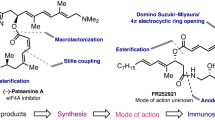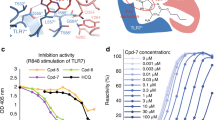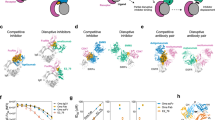Abstract
We describe the rational design of immunosuppressive peptides without relying on information regarding their receptors or mechanisms of action. The design strategy uses a variety of topological and shape descriptors in combination with an analysis of molecular dynamics trajectories for the identification of potential drug candidates. This strategy was applied to the development of immunosuppressive peptides with enhanced potency. The lead compounds were peptides, derived from the heavy chain of HLA class I, that modulate immune responses in vitro and in vivo. In particular, a peptide derived from HLA-B2702, amino acids 75–84 (2702.75–84) prolonged skin and heart allograft survival in mice. The biological activity of the rationally designed peptides was tested in a heterotopic mouse heart allograft model. The molecule predicted to be most potent displayed an immunosuppressive activity approximately 100 times higher than the lead compound.
This is a preview of subscription content, access via your institution
Access options
Subscribe to this journal
Receive 12 print issues and online access
$209.00 per year
only $17.42 per issue
Buy this article
- Purchase on Springer Link
- Instant access to full article PDF
Prices may be subject to local taxes which are calculated during checkout
Similar content being viewed by others
References
Good, A., So, S. and Richards, W.G. 1993. Structure-activity relationships from molecular similarity matrices. J. Med. Chem. 36: 433–437.
Hyde, R. and Livingstone, D. 1988. Perspectives in QSAR: computer chemistry and pattern recognition. J. Comput. Aided Mol. Des. 2: 145–151.
Wiener, H. 1947. Correlation of heats of isomerization and differences in heats of vaporization of isomers, among the paraffin hydrocarbons. J. Am. Chem. Soc. 69: 2636–2642.
Mihalic, Z. and Trinajstic, N. 1992. A graph-theoretical approach to structure-property relationships. J. Ed. Chem. 69: 701–705.
Nikolovska-Coleska, Z., Sutrkova, L., Dorevski, K., Krbavcic, A. and Solmajer, T. 1998. Quantitative structure activity relationship of flavonoid inhibitors of p56kk protein tyrosyne kinase: a classical/quantum chemical approach. Quant. Struct.Act. Relat. 17: 20–26.
Seydel, J., Cordes, H.P., Albores-Velasco, M., Visser, K. and Wiese, M. 1993. Methods and parameters to describe drug membrane interaction and their use in QSAR, pp. 120–123 in Trends in QSAR and Molecular modelling 92, Wermuth, C.G. (ed.). ESCOM Publishers, Leiden, Netherlands.
Hatch, K. and Magee, P. 1998. A discriminant model for allergic contact dermatitis in anthraquinone disperse dyes. Quant. Struct. Act fie/at 17: 7–13.
Devillers, J. and Domine, D. 1994. Deriving structure-chemoreception relationships from the combined use of linear and non-linear multivariate analyses, 57–60 in QSAR and molecular modelling: concepts, computational tools, and biological applications, Sanz, R, Giraldo, J., and Manuat, F. (eds.). Prous Science Publishers, Barcelona.
Grassy, G., Trape, P., Bompart, J., Calas, B. and Auzou, G. 1995. Variable mapping of structure activity relationships. Application to 17-Spirolactone derivatives with mineralocorticoid activity. J. Mol. Graphics 13: 356–367.
Clayberger, C., Lyu, S.C., Pouletry, P., and Krensky, A.M. 1993. Peptides corresponding to T-cell receptor-HLA contact regions inhibit class l-restricted Immune responses. Transplant Proc. 25: 477–478.
Nisco, S., Vriens, P., Hoyt, G., Lyu, S.C., R, Pouletry, P. et al. 1994. Induction of allograft tolerance in rats by an HLA class-l-derived peptides and cyclosporine A. J. Immunol. 152: 3786–3792.
Cuturi, M.C., Josien, R., Douillard, P., Pannetier, C., Cantarovitch, D., Smit, H. et al. 1995. Prolongation of allogeneic heart graft survival in rats by administration of a peptide (a.a 75–84) from the a1 helix of the first domain of HLA-B701. Transplantation 59: 661–669.
Gao, L., Woo, J. and Buelow, R. 1996. Both L- and D-isomers of HLA class I heavy chain derived peptides prolong heart allograft survival in mice. Heart and Lung Transplantation 15: 78–87.
Noessner, E., Goldberg, J.E., Naftzger, C., Lyu, S.C., Clayberger, C. and Krensky, A.M. 1996. HLA-derived peptides which inhibit T-cell function bind to members of the heat shock protein 70 family. J. Exp. Med. 183: 339–348.
Buelow, R., Veyron, P., Clayberger, C., Pouletry, P. and Touraine, J.L. 1995. Prolongation of skin allograft survival in mice following administration of allotrap. Transplantation 59: 455–460.
Woo, J., Iyer, S., Cornejo, M.C., Gao, L., Cuturi, C., Soulillou, J.R. and Buelow, R. 1997. Immunosuppression by HLA class I heavy chain (amino acid 75 to 84). derived peptides is independent of binding to Hsc70. Transplantation 64: 1460–1467.
Giral, M., Cuturi, M.C., N'guyen, J.M., Josien, R., Dantal, J., Floc'h, R. et al. 1997. Decreased cytotoxic activity of natural killer cells in kidney allograft recipients treated with human HLA-derived peptide. Transplantation 63: 1004–1011.
Buelow, R., Burlingham, W.H. and Clayberger, C. 1995. Immunomodulation by soluble HLA Class I. Transplantation 59: 649–654.
Ghose, A. and Crippen, G.M. 1986. Physicochemical parameters for three dimensional structure-directed quantitative structure-activity relationships. I. Partition coefficient as a measure of hydrophobicity. J. Comput. Chem., 7: 565–677.
Balaban, A.T. 1982. Highly discriminating distance-based topological index. Chem. Phys. Lett. 89: 399–402.
See for instance, Hall, L.H. and Kier, L.B. 1992. The molecular connectivity chi indexes and kappa shape indexes in structure-property modeling. Reviews in Computational Chemistry Ed. K.B. Lipkowitz and D.B. Boyd and references herein.
Iyer, S., Woo, J., Cornejo, M.C., Gao, L., McCoubrey, W., Maines, M. and Buelow, R. 1998. Characterization and biological significance of immunosup-pressive peptide D2702. 75-84 (EV) binding protein: isolation of heme oxyge-nase. J. Biol. Chem. 273: 2692–2697.
Woo, J., Iyer, S., Comejo, M.C., Mori, N., Gao, L. and Buelow, R. 1998. Stress induced immunosuppression: inhibition of cellular immune effector functions following overexpression of heat shock protein 32. Transplantation Immunology. In press.
Willis, D., Moore, A.R., Frederick, R. and Willoughby, D.A. 1996. Heme oxygenase: A novel target for the modulation of the inflammatory response. Nat. Medicine 2: 87–90.
Laniado-Schwartzmann, M., Abraham, N.G., Conners, M., Dunn, M.W., Levere, R.D. and Kappas, A. 1997. Heme oxygenase induction with attenuation of experimentally induced corneal inflammation. Biochem. Pharmacol. 53: 1069–1075.
Ono, K. and Lindsey, E.S. 1969. Improved technique of heart transplantation in rats. J. Thorac. Cardiovasc. Surg. 7: 225–229.
Broto, P., Moreau, G. and Van Dycke, C. 1984. Molecular structures: perception, autocorrelation descriptor and SAR studies. Eur. J. Med. Chem.-Chim. Theor. 19: 61–70.
Grassy, G. and Lahana, R. 1993. Statistical analyses and shape recognition. Applications to molecular dynamics simulations, conformational analyses and structure-activity relationships, pp. 216–219 in Trends in QSAR and Molecular modelling 92 ESCOM Publishers.
Yasri, A., Chiche, L., Haiech, J. and Grassy, G. 1996. Rational choice of molecular dynamics simulation parameters through the use of conformational autocorrelation 3-D method. Application to calmoduline flexibility study. Protein Engineering 9: 959–976.
Author information
Authors and Affiliations
Rights and permissions
About this article
Cite this article
Grassy, G., Calas, B., Yasri, A. et al. Computer-assisted rational design of immunosuppressive compounds. Nat Biotechnol 16, 748–752 (1998). https://doi.org/10.1038/nbt0898-748
Received:
Accepted:
Issue Date:
DOI: https://doi.org/10.1038/nbt0898-748
This article is cited by
-
On the Balaban Index of Chain Graphs
Bulletin of the Malaysian Mathematical Sciences Society (2021)
-
Distance based indices in nanotubical graphs: part 3
Journal of Mathematical Chemistry (2021)
-
Distance based indices in nanotubical graphs: part 2
Journal of Mathematical Chemistry (2018)
-
Probing the opportunities for designing anthelmintic leads by sub-structural topology-based QSAR modelling
Molecular Diversity (2018)
-
Distances on nanotubical structures
Journal of Mathematical Chemistry (2016)



